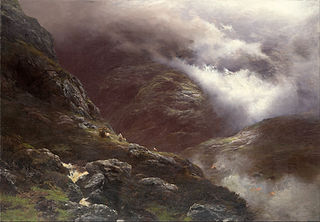
The Massacre of Glencoe took place in Glen Coe in the Highlands of Scotland on 13 February 1692. An estimated 30 members and associates of Clan MacDonald of Glencoe were killed by Scottish government forces, allegedly for failing to pledge allegiance to the new monarchs, William III and Mary II.

Clan Campbell is a Highland Scottish clan, historically one of the largest and most powerful of the Highland clans. The Clan Campbell lands are in Argyll and within their lands lies Ben Cruachan. The chief of the clan became Earl of Argyll and later Duke of Argyll.
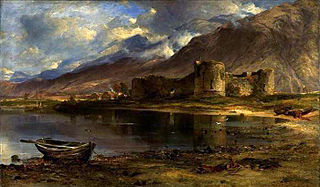
The Battle of Inverlochy occurred on 2 February 1645, during the Wars of the Three Kingdoms, when a Royalist force of Highlanders and Confederate Irish troops under the overall command of James Graham, 1st Marquess of Montrose, routed and largely destroyed the pursuing forces of Archibald Campbell, 1st Marquess of Argyll, who had been encamped under the walls of Inverlochy Castle.

Clan Donald, also known as Clan MacDonald or Clan Mc Donald, is a Highland Scottish clan and one of the largest Scottish clans. The Lord Lyon King of Arms, the Scottish official with responsibility for regulating heraldry in that country, issuing new grants of coats of arms, and serving as the judge of the Court of the Lord Lyon, recognises under Scottish law the High Chief of Clan Donald. Historically the chiefs of the Clan Donald held the title of Lord of the Isles until 1493 and two of those chiefs also held the title of Earl of Ross until 1476.

Between 1639 and 1652, Scotland was involved in the Wars of the Three Kingdoms, a series of conflicts which included the Bishops' Wars, the Irish Rebellion of 1641, the English Civil War, the Irish Confederate Wars and finally the conquest of Ireland and the subjugation of Scotland by the English New Model Army.
Alasdair Mac Colla Chiotaich MacDhòmhnaill, also known by the English variant of his name Sir Alexander MacDonald, was a military officer best known for his participation in the Wars of the Three Kingdoms, notably the Irish Confederate Wars and Montrose's Royalist campaign in Scotland during 1644–45. A member of the Gaelic gentry of the Clan MacDonald of Dunnyveg, a branch of the Clan Donald active in the Hebrides and Ireland, Mac Colla is particularly notable for the very large number of oral traditions and legends which his life inspired in the Highlands.

The Battle of Aberdeen, also known as the Battle of Justice Mills and the Crabstane Rout, was an engagement in the Wars of the Three Kingdoms which took place outside the city of Aberdeen on 13 September 1644. During the battle, Royalist forces led by James Graham, Lord Montrose routed an army raised by the Covenanter-dominated Parliament of Scotland under Robert Balfour, 2nd Lord Balfour of Burleigh.
The Battle of Auldearn was an engagement of the Wars of the Three Kingdoms. It took place on 9 May 1645, in and around the village of Auldearn in Nairnshire. It resulted in a victory for the royalists, led by the Marquess of Montrose and Alasdair MacColla, over Sir John Urry and an army raised by the Covenanter-dominated Scottish government.

The Battle of Dunaverty involved a battle and the siege of Dunaverty Castle in Kintyre, Scotland, in 1647. The events involved the Covenanter Army under the command of General David Leslie on one side and 200–300 Highland troops under the command of Archibald Og of Sanda on the other.
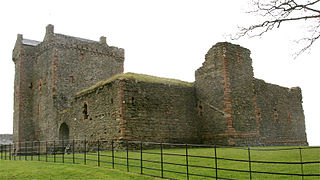
Skipness Castle stands on the east side of the Kintyre peninsula in Scotland, near the village of Skipness. Together with the nearby Kilbrannan Chapel it is a scheduled ancient monument.

Clan Lamont is a Highland Scottish clan. The clan is said to descend from Ánrothán Ua Néill, an Irish prince of the O'Neill dynasty, and through him Niall Noigíallach, High King of Ireland. Clan Ewen of Otter, Clan MacNeil of Barra, Clan Lachlan, and Clan Sweeney are also descendants of Ánrothán. Traditional genealogy would therefore include Clan Lamont among the descendants of Conn Cétchathach.

The MacDonalds of Glencoe, also known as Clann Iain Abrach, is a Highland Scottish clan and a branch of the larger Clan Donald. Named after Glen Coe, the MacDonalds lived there from the early 14th century, until the glen was largely abandoned during the Highland Clearances of the late 18th century.
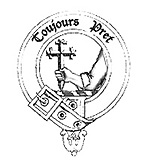
Clan MacDonald of Dunnyveg, also known as Clan Donald South, Clan Iain Mor, Clan MacDonald of Islay and Kintyre, MacDonalds of the Glens (Antrim) and sometimes referred to as MacDonnells, is a Scottish clan and a branch of Clan Donald. The founder of the MacDonalds of Dunnyveg is Eòin Mòr Tànaiste Mac Dhòmhnaill, a son of Iain Mic Dhòmhnaill and Margaret Stewart of Scotland, daughter of King Robert II. Members of the clan actually pronounced and spelled their name M'Connall due to the Gaelic pronunciation of the name Mac Domhnuill thus giving rise to the surname McConnell and its variants. While historically recognised as a clan by the Court of the Lord Lyon, it is now an armigerous clan as it no longer has a chief. The last chief was Sir James MacDonald, 9th of the Clan MacDonald of Dunnyveg or Clan Donald South, who died in London in 1626.

The MacDonnells of Antrim, also known as the MacDonnells of the Glens, are a branch in Ireland of the Scottish-based Clan Donald. Initially part of Clan MacDonald of Dunnyveg, the MacDonnells of Antrim became their own branch in 1558 when Somhairle Buidhe MacDonnell obtained the lordship of the territory in Ireland from James MacDonald, 6th chief of the Clan MacDonald of Dunnyveg.
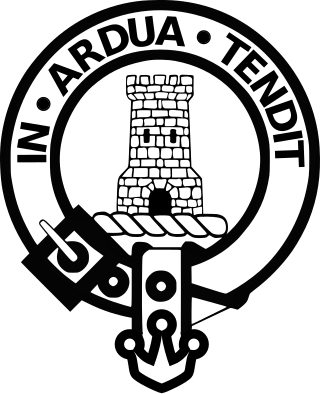
The Clan Malcolm, also known as the Clan MacCallum, is a Highland Scottish clan. The Clan MacCallum may have originally been a separate clan until the 18th century, when the chief of the Clan MacCallum adopted the name Malcolm after inheriting the Malcolm estate, and the two clans were drawn together under the same chief.
Manus O'Cahan's Regiment of Foot was an Irish regiment which served during the Wars of the Three Kingdoms in the mid-1640s.
Coll Ciotach Mac Domhnaill (1570–1647) was a Scottish adventurer and mercenary of the Clan MacDonald of Dunnyveg branch of Clan Donald, who became Laird of Colonsay in 1623, by treachery. His name, which means "Coll the left-handed" or "the crafty", was anglicised as Colkitto. However he only used the nickname Ciotach late in his life in 1629 when it appeared in a Latin translation of a Gaelic letter where Coll refers to himself as "Ego Collatius Kiotach Macdonnell".

Redshank was a nickname for Scottish mercenaries from the Highlands and Western Isles contracted to fight in Ireland; they were a prominent feature of Irish armies throughout the 16th century. They were called redshanks because they went dressed in plaids and waded bare-legged through rivers in the coldest weather. An alternative etymology, illustrated by Jamieson by a quote from Sir Walter Scott, is that it referred to the untanned deer leather buskins worn by Highlanders, although Jamieson notes that Scott's source, John Elder of Caithness, actually stated its origin was from their habit of going "bare-legged and bare-footed". The term was not derogatory, as the English were in general impressed with the redshanks' qualities as soldiers.

Sir Lachlan Maclean, 1st Baronetof Morvern, was a Scottish nobleman and the 17th Chief of Clan Maclean. He was granted his Baronet title by Charles I and he became the Clan Chief on the death of his brother in 1626. He fought as a Royalist under James Graham, 1st Marquess of Montrose during the Wars of the Three Kingdoms at the Battle of Inverlochy, Battle of Auldearn and Battle of Kilsyth. From 1628 to 1633 he sat in the Parliament of Scotland as shire commissioner for Tarbert. From his rule onward, all Maclean clan chiefs are successive Baronets of Movern.

The Irish Confederate expedition to Scotland took place in 1644–1645 during the Wars of the Three Kingdoms. A force of about 2,000 Irish Confederate troops, under the command of Alasdair Mac Colla, sailed to Scotland in June 1644, where they joined with Royalist forces fighting Montrose's Highland campaign against the Covenanters. The expedition was the result of an effort by King Charles I to enlist help from Irish Catholics in fighting Parliamentarian forces.

















